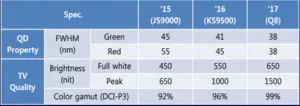The QLED and HDR10+ Summit at IFA was organized by Insight Media with sponsorship from Samsung Electronics. It ran on September 1 at the Waldorf Astoria Berlin hotel and attracted over 100 industry professionals and media.
The day started with an overview of quantum dot technology by Chris Chinnock, founder and president of Insight Media. He noted that marketing of wide color gamut TVs often describes them as “wide color gamut”, but there is no clear definition of this term, although most seem to use it for a color gamut in excess of BT.709. There are also many methods of achieving a wide color gamut such as using a blue LED with a YAG and red phosphor, a blue LED with green and red phosphors, using a conventional blue LED and YAG phosphor with a yellow notch filter, using RGB LEDs or RGB lasers and using quantum dots. Most of these methods can now achieve more than 90% coverage of the DCI-P3 color gamut, but it may be quantum dots that have the best potential to push beyond P3 toward 2020.
He explained that there are two classes of quantum dots: photoluminescent (emission activated by light) and electroluminescent (emission activated by current). Only the photoluminescent type is commercialized today.
There are also a broad range of quantum dot materials and structure such as the sized-based approach (size of the quantum dot determines the output wavelength), composition-based, Perovskites and even quantum rods (which emit polarized light). Only the size-based approach has been commercialized so far.
Within this category, there is a clear trend to move from Cd-based to Cd-free compounds and to move from non-air-stable to air-stable materials. Currently there are no commercial air-stable quantum dot materials so expensive barrier films are need to protect the materials from air and moisture. Commercializing air-stable quantum dots and scaling up the manufacturing capacity are both needed to lower costs of quantum dots and enable them to move from premium products to more mainstream products.
Today, only the film-based approach is being used in quantum dot displays but there is research on-going into other architectures such as color filter, QD on LEDs, hybrid approaches with OLEDs, QDs on microLEDs, and electroluminescent.
He closed by showing a family tree of quantum dot technologies under the banner of QLEDs (using Samsung’s definition that any display with quantum dots inside is a QLED device).

